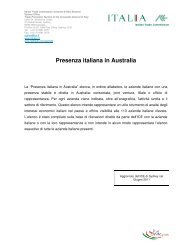Price Determination in the Australian Food Industry A Report
Price Determination in the Australian Food Industry A Report
Price Determination in the Australian Food Industry A Report
Create successful ePaper yourself
Turn your PDF publications into a flip-book with our unique Google optimized e-Paper software.
• The major cost faced by egg producers is feed. This represents approximately 60 per cent of<br />
costs of production <strong>in</strong> normal conditions.<br />
• Whilst <strong>the</strong> general level of retail and wholesale prices have been historically driven by a costplus<br />
approach, s<strong>in</strong>ce deregulation of <strong>the</strong> supply and pric<strong>in</strong>g of eggs, fluctuations <strong>in</strong> pric<strong>in</strong>g have<br />
been determ<strong>in</strong>ed largely by variations <strong>in</strong> available egg supply.<br />
• In recent times, <strong>the</strong> level of retail prices has been strongly <strong>in</strong>fluenced by greater use of private<br />
label product by major retailers – lead<strong>in</strong>g to m<strong>in</strong>imal <strong>in</strong>creases <strong>in</strong> prices to <strong>the</strong> consumer.<br />
• Major cha<strong>in</strong> retailers have driven an <strong>in</strong>crease <strong>in</strong> <strong>the</strong> market share held by private label product<br />
to combat competition for <strong>the</strong>ir egg sales from <strong>the</strong> non-<strong>in</strong>tegrated box market which sees<br />
discount<strong>in</strong>g at <strong>in</strong>dependent outlets.<br />
Figure 94. Eggs: Major drivers of prices and costs<br />
Cage eggs are a major grocery category where over time <strong>the</strong> production <strong>in</strong>dustry has gone through substantial change and<br />
restructure, with strong rationalisation of grow<strong>in</strong>g and market<strong>in</strong>g sectors.<br />
1. Farm production factors<br />
• Production has tended to be volatile<br />
due to movements <strong>in</strong> supply <strong>in</strong><br />
response to price signals.<br />
• Product is perishable with a limited<br />
shelf life for optimum freshness.<br />
• There are long lead times to scale up<br />
production yet flock reductions can<br />
be immediate through cull<strong>in</strong>g.<br />
• Production profit is sensitive to<br />
fluctuations <strong>in</strong> feed costs.<br />
2. Value-cha<strong>in</strong> <strong>in</strong>tegration<br />
• Instability of price and return for growers and<br />
marketers due to an <strong>in</strong>ability to ma<strong>in</strong>ta<strong>in</strong> a stable<br />
match between demand and supply.<br />
• Increas<strong>in</strong>g scale efficiency <strong>in</strong> egg farms, grad<strong>in</strong>g<br />
and pack<strong>in</strong>g operations.<br />
• Strong concentration of ownership <strong>in</strong> <strong>the</strong><br />
collection, grad<strong>in</strong>g, pack<strong>in</strong>g and market<strong>in</strong>g<br />
stages.<br />
• Consolidation of egg market<strong>in</strong>g <strong>in</strong>to a small<br />
number of companies operat<strong>in</strong>g <strong>in</strong> different<br />
zones has enhanced barga<strong>in</strong><strong>in</strong>g power of<br />
marketers.<br />
• Box market rema<strong>in</strong>s a large share of market – <strong>in</strong><br />
disaggregated form where packers supply direct<br />
to retail.<br />
3. The market<strong>in</strong>g approach<br />
• Limited differentiation and<br />
de-commoditis<strong>in</strong>g at retail.<br />
• Brand presence still strong <strong>in</strong><br />
major retail sectors with<br />
strong price competition<br />
aga<strong>in</strong>st box market and<br />
private label.<br />
• Packag<strong>in</strong>g and presentation is<br />
reasonably generic.<br />
• Market<strong>in</strong>g approach based on<br />
<strong>the</strong> relative cost of eggs as a<br />
prote<strong>in</strong> source.<br />
• Small niches carved out for<br />
free-range egg l<strong>in</strong>es <strong>in</strong> all<br />
forms of retail, but supply<br />
l<strong>in</strong>es less reliable.<br />
Grow<strong>in</strong>g<br />
Grade and pack<strong>in</strong>g<br />
Market<strong>in</strong>g<br />
Distribution<br />
Retail<br />
<strong>Food</strong> service<br />
<strong>Price</strong> <strong>Determ<strong>in</strong>ation</strong> <strong>in</strong> <strong>the</strong> <strong>Australian</strong> <strong>Food</strong> <strong>Industry</strong> A <strong>Report</strong><br />
4. Regulation and<br />
compliance<br />
• Major challenge fac<strong>in</strong>g<br />
producers is compliance<br />
(over any time up to<br />
2008) with new cage<br />
size regulations. These<br />
will require re-equipp<strong>in</strong>g<br />
across <strong>the</strong> sector.<br />
• Uncerta<strong>in</strong>ty over <strong>the</strong><br />
extent of <strong>the</strong> future<br />
impact of that capital<br />
requirement on<br />
production levels and<br />
accord<strong>in</strong>gly on temporal<br />
match<strong>in</strong>g of supply and<br />
demand.<br />
5. Trade impacts<br />
• Limited exports of<br />
powdered eggs helps<br />
remove small market<br />
surpluses.<br />
• Small volume of shell egg<br />
exports out of Western<br />
Australia has m<strong>in</strong>imal effect<br />
on east coast market.<br />
• No shell egg imports are<br />
permitted under <strong>Australian</strong><br />
Quarant<strong>in</strong>e and Inspection<br />
Service rules.<br />
6. Technology and <strong>in</strong>novation<br />
• Increas<strong>in</strong>g capital <strong>in</strong>tensity is<br />
improv<strong>in</strong>g cost structures <strong>in</strong><br />
grad<strong>in</strong>g and pack<strong>in</strong>g sector.<br />
• Limited transparency of<br />
market prices and costs<br />
through <strong>the</strong> box market<br />
channel cha<strong>in</strong>, yet retail<br />
market is highly visible.<br />
• Limited new product<br />
development over recent<br />
years.<br />
• Limited scope to diversify<br />
core product due to its<br />
uniform, consistent nature –<br />
yet development of<br />
powdered egg products and<br />
pre-cooked products for food<br />
service has occurred.<br />
7. Retail market dynamics<br />
• Diverse retail market with<br />
major cha<strong>in</strong>s only hav<strong>in</strong>g<br />
about 40% of market.<br />
• The growth of <strong>the</strong> private<br />
label <strong>in</strong> eggs has been<br />
strongly based on price<br />
competition <strong>in</strong> order for<br />
retailers to ga<strong>in</strong> greater<br />
share of total market.<br />
• Greater demand for<br />
convenience and lifestyle<br />
solutions <strong>in</strong> meals and<br />
foods has put pressure on<br />
<strong>the</strong> egg as a fresh food<br />
option.<br />
• <strong>Price</strong>s deemed sensitive at<br />
retail po<strong>in</strong>t of sale.<br />
• Grow<strong>in</strong>g diversity of<br />
consumer needs will see<br />
<strong>in</strong>creas<strong>in</strong>g demand for<br />
processed products <strong>in</strong><br />
food preparation solutions.<br />
88







